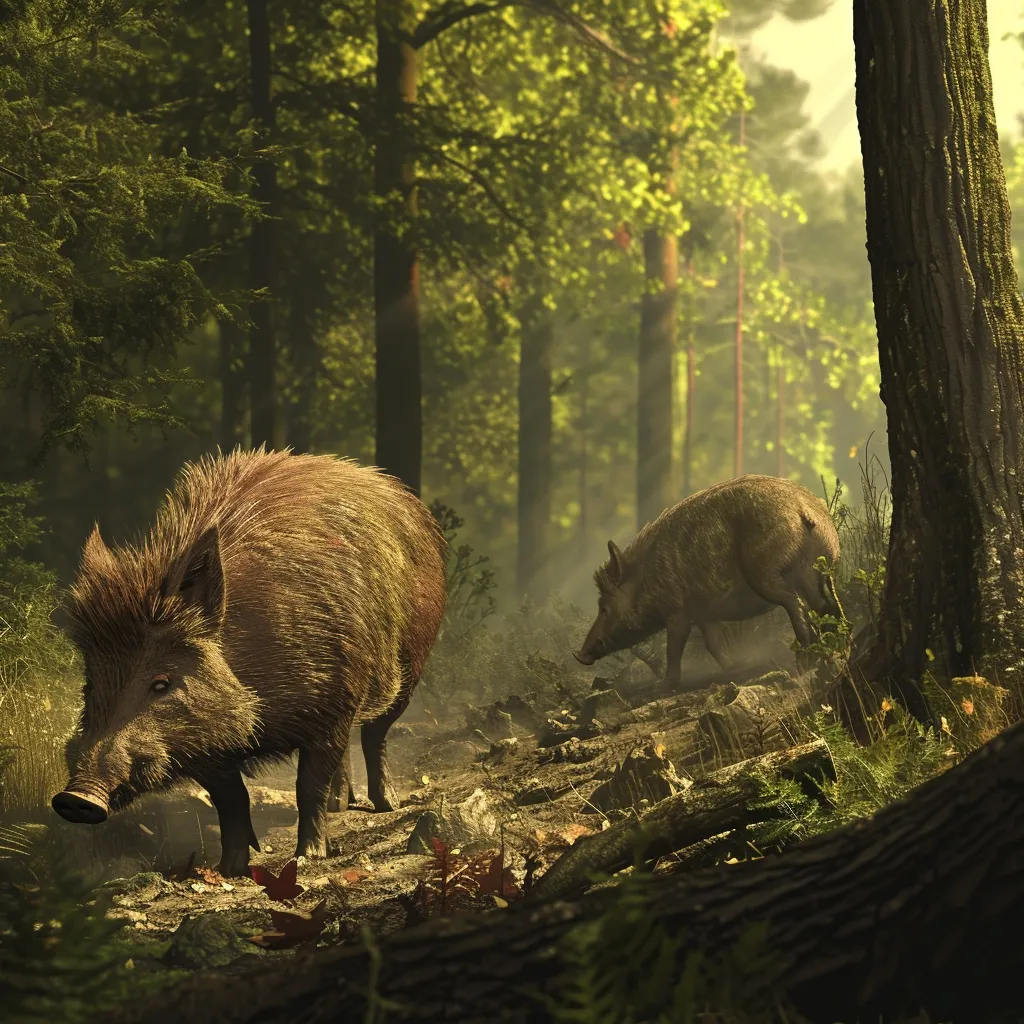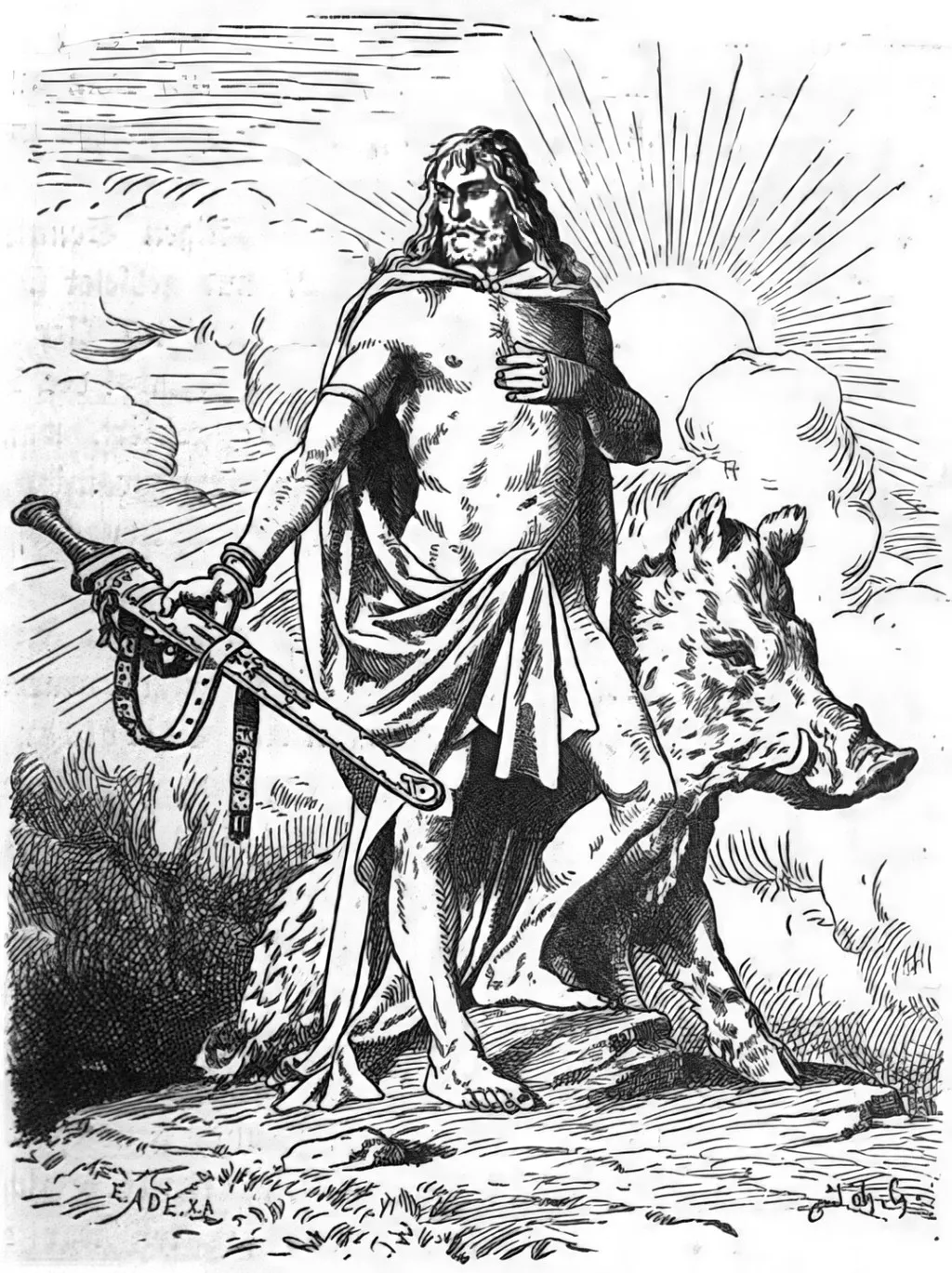Gullinbursti (GUL-in-BUR-stee)
Golden-Bristled Boar
It begins with a flicker—not of flame, but of reflection. Along the low rise where bracken thickens and dusk pools like honey, something glints through the undergrowth. It moves as if the forest itself has remembered an ancient momentum. Gullinbursti does not burst from cover. It emerges, as though shaped by light, its bristles catching the last breath of the sun and sending it back in lines too bright to hold.
It leaves no trail, yet its passing rearranges memory. Where it treads, fallen branches seem freshly set, and the moss closes over footprints before they are seen. The underbrush quiets not in fear, but in acknowledgement. Birds pause mid-call. Insects still their wingbeats. The world pauses as though cued by something older than sound. Gullinbursti does not run or trot—it surges, steady and low, as if plowing through the hour itself.
Its form appears briefly in the breaks between trees, always at the edge of view. It might crest a knoll and vanish, or hold still beneath the spread of a tree whose shadow does not quite match the sun. When it pauses, the light around it seems denser—more golden, more real. It is not that it brings radiance, but that it reveals where radiance had been waiting to bloom.
Those who have watched Gullinbursti pass speak of feeling somehow reordered. Their limbs feel less restless, their thoughts more grounded. It does not alter the landscape. It recalls it. The very dust that lifts from its trail seems to shimmer with gratitude, as though stirred not by weight, but by truth made briefly visible.
The creature does not linger. It has no audience. It travels as a memory in motion—its path not chosen, but remembered. To see Gullinbursti is not to witness an event, but to stand in the midst of a cycle completing itself once more, flawlessly, without fanfare or demand.
In Norse mythology, Gullinbursti is the golden boar forged by dwarves for Freyr, god of fertility and peace. The Tír na nÓg being shares its name and luminance, though not its origin. It echoes the mythic role through its association with land rhythm and continuity of motion—its golden shimmer not divine, but deeply terrestrial. Germany – Saxon Boar Symbols
Among early Germanic tribes, boars symbolized resilience and the sacred bond between earth and movement. Helmets and standards bore golden boar imagery. Gullinbursti reflects these emblems in its visual rhythm—unstoppable, radiant not with heat, but with enduring resonance. Estonia – Kalevipoeg Cycle
Estonian epic tradition speaks of golden animals tied to the land’s fate. Though Gullinbursti does not act within narrative, its appearance near ancient stone barrows and song sites resonates with these myths, forming a quiet bridge between visibility and remembrance.
Behavior & Communication
Gullinbursti moves with rhythmic surging strides, primarily at dawn and dusk intervals when ambient aether levels peak at transitional tones. It maintains a consistent direction across open terrain and forest margins, altering course only to follow established resonance lines. There is no indication of group behavior or variation in stride across terrain types. Communication is non-vocal and expressed through bristle modulation. During movement, its bristles remain flat, refracting light in tight bands. During rest, they raise and shimmer in widening arcs, diffusing ambient illumination across a broader range. This shimmer appears to function as a spatial declaration—deterring overlap from other energy-bearing fauna while reinforcing its own trajectory. Although solitary, Gullinbursti has been observed to create temporary wakefields—zones of lingering harmonic presence—lasting up to an hour after its passage. These fields exhibit measurable influence on nearby leaf cluster orientations and low-lying root pulse regulation. Its awareness of other beings appears peripheral and unresponsive; its path is fixed regardless of external proximity. When stationary, it maintains a low center of mass and folds its legs under the body in a compact resting state. This rest posture is rare, occurring only in valleys aligned with known solar convergence zones, and may coincide with atmospheric thinning cycles. The shimmer of its bristles during these periods increases in vibrancy and range.Ecological Niche
Gullinbursti inhabits temperate lowwood and reflective meadowland with a preference for ridgelines and rolling fieldstone environments. It thrives in terrains with scattered vegetation and exposed mineral composition, particularly quartz-streaked soils and mica-bearing outcroppings. These materials amplify the aetheric signature of its movement and bristle resonance. Its presence influences the orientation and distribution of nearby flora. Leaf angles and seed pod retention rates appear to shift subtly in alignment with its recent passage. In locations of frequent activity, ambient vibrational fields remain stable through high-wind events, suggesting the creature serves as an environmental anchor. The being does not create dens, nor does it remain in any location for more than a half-day interval. Instead, it travels known routes that form loops over wide ranges, typically returning to the same point only after full lunar or solar cycles. These routes have been mapped by field researchers and often trace dormant leyline crosspoints or sites of ancient mortal reverence.Common Myths & Legends
Scandinavia – Norse TraditionIn Norse mythology, Gullinbursti is the golden boar forged by dwarves for Freyr, god of fertility and peace. The Tír na nÓg being shares its name and luminance, though not its origin. It echoes the mythic role through its association with land rhythm and continuity of motion—its golden shimmer not divine, but deeply terrestrial. Germany – Saxon Boar Symbols
Among early Germanic tribes, boars symbolized resilience and the sacred bond between earth and movement. Helmets and standards bore golden boar imagery. Gullinbursti reflects these emblems in its visual rhythm—unstoppable, radiant not with heat, but with enduring resonance. Estonia – Kalevipoeg Cycle
Estonian epic tradition speaks of golden animals tied to the land’s fate. Though Gullinbursti does not act within narrative, its appearance near ancient stone barrows and song sites resonates with these myths, forming a quiet bridge between visibility and remembrance.
| APPEARANCE/PHENOTYPE |
|---|
| Porcine-bodied and broad-shouldered, Gullinbursti features dense musculature and a heavy, wedge-shaped skull. Its bristles are metallic gold at their tips, tapering to russet near the roots, and remain in constant, slow motion, even when the creature is still. Tusks are shallowly curved and dull-edged, extending laterally before sweeping forward. Its hooves are thick and dark-polished, with a faint internal glow when in motion. The eyes are small and bronze-colored, set deep beneath a sloped brow. Flank and underbelly reflect ambient light more strongly than the dorsal line, enhancing its gradient effect in motion. |
height |
length |
weight |
|---|---|---|
1.4 m |
2.1 m (including tail) |
210 kg |
Genetic Ancestor(s)
Scientific Name
Ainmhí; Réamhach; Brillorhynchus gullinbursti
Origin/Ancestry
Their lineage traces back to the legendary golden boar, once a divine creation, now an integral part of the island's enchanted woodlands.
Ancient Gullinbursti
The god Freyr stands with his sword and the boar Gullinbursti.


















